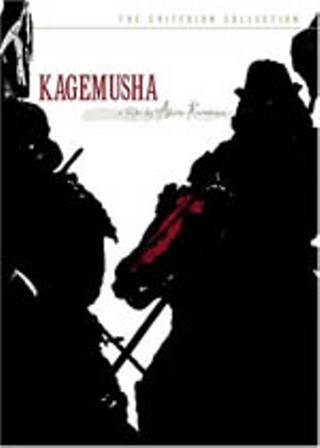Kagemusha
All of the director's classic themes and techniques are here, but 'Kagemusha' also ushered in a new period in Kurosawa's style, one influenced by the countless hours, months, and years he spent painting imagined scenes from the movie as he waited dejectedly for funding to come in
Reviewed by Josh Rosenblatt, Fri., April 8, 2005

Kagemusha
Criterion, $39.95
Born out of the despair and depression that were writer/director Akira Kurosawa's lot after several commercial failures in the Sixties and Seventies left him without work or hope, Kagemusha is a despondent, existential movie, distant and saturated with death, permitting its wounded protagonists to get close enough to happiness only so they might recognize it when it passes them in the rainy night. Like so much of Kurosawa's work, the film is enormous and grand and built to last, like a museum or cathedral – a reminder to the world.The story is both simple and full of snares: Against the backdrop of war-ridden 16th-century Japan, a worthless thief is saved from crucifixion to act as double to Shingen, a powerful and feared feudal lord; this buffoon becomes a "shadow warrior," a stalking horse for the state that made him a criminal. At base, this is a story about identity, about the identities people create or have created for them and that lock them into lives they don't choose. It's also about the lives that are led forever in the shadows of greater men, the insignificant lives. All the major players in this story are cursed with the knowledge that they are pale comparisons to the man they are replacing, or son to, or enemy of. Kagemusha's themes are epic in scope and universal in relevance and the story Kurosawa is telling shakes with the sounds of immense armies and determined leaders. Yet, all along, he's weaving a very small and human drama about individuals searching for their place in a placeless universe.
Kurosawa always had a gift for combining the most formally framed shots – a nod to his affinity for Japanese art and his training in Japanese film – with the explosiveness and exuberance of the American Westerns he loved, and Kagemusha is no exception. Every scene is a small masterpiece of detail, staging, and choreography, yet we're always aware of the world raging outside the confines of the camera's eye: The winds never cease rattling the gates. All of the director's classic themes and techniques are here, but Kagemusha also ushered in a new period in Kurosawa's style, one influenced by the countless hours, months, and years he spent painting imagined scenes from the movie as he waited dejectedly for funding to come in, constructing the film shot by shot in his head.
All the drama and effort that went into the making of the movie is given time on the accompanying documentaries on disc two. "Kurosawa: To Create Is Beautiful" is a view into the making of Kagemusha and the man's creative process in general. In the most collaborative of art forms, Kurosawa was both the stubborn, temperamental master – demanding obedience and loyalty to his single vision – and the most generous of collaborators, deferring to the expertise of his cameramen, lighting designers, and composers when he felt their opinions best facilitated the transition of his ideas to film. The interviews with those who worked with him on this movie are a fitting tribute to a man who often said he was happier spending time with his crew than his family – a true artist who, according to anecdote, "lived his life for film."
Also Out Now
My Own Private Idaho (Criterion): Gus Van Sant takes on Henry IV and narcolepsy, not necessarily in that order.Buster Keaton/Charlie Chaplin (Direct Source): For just $6.99, you can watch the Great Stoneface show the Tramp what for.
Upcoming
Hoop Dreams (Criterion): Steve James' story of two inner-city kids fighting for something the world doesn't want them to have.










